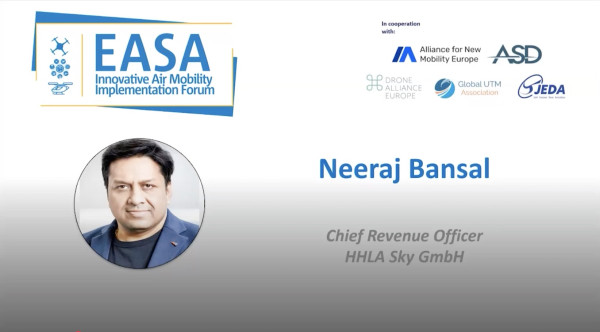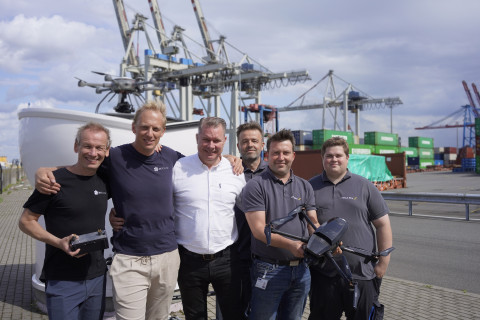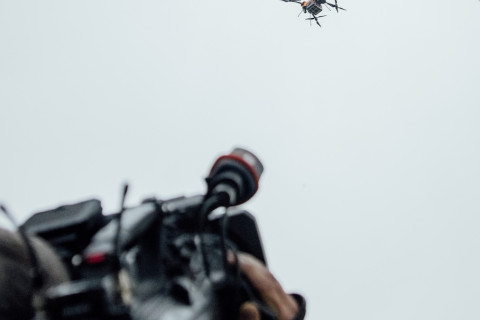Innovative Air Mobility Implementation Forum: Insights from HHLA Sky

Neeraj Bansal, Chief Revenue Officer at HHLA Sky, addressed the European Union Aviation Safety Agency (EASA) Innovative Air Mobility Implementation Forum, emphasizing the critical role of standards, integration, and safety in advancing the drone industry.
As a subsidiary of the HHLA Group, the Port of Hamburg’s leading logistics operator, HHLA Sky brings a unique perspective to the air mobility landscape, rooted in decades of operational expertise across multimodal transport networks.
EASA’s Innovative Air Mobility Implementation Forum focused on the status of the innovative air mobility and U-space regulatory framework and was an opportunity for all actors within the IAM ecosystem to present on technical and regulatory matters and bring forward proposals on best practices for safe and sustainable development of the EU drone market.
We were honored to be invited by EASA to present our findings and justifications for developing our drone and UTM solutions.
Recognizing Industry Progress
Neeraj began by acknowledging EASA’s pivotal contributions to establishing common standards and regulations. Drawing parallels with the telecommunications sector’s early years, marked by uncoordinated frameworks, he highlighted the value of EASA’s proactive approach in harmonizing aviation practices.
“I don’t think we ever really appreciate all the good work that the EASA is doing because we always are looking for more perfection, but we never appreciate what we have,” Neeraj said. “I can actually say that because I come from a world of telecom, and when the 2G and the 3G and these things were starting, when the TDMA and CDMA systems were there, I know how unorganized the industry was, how unspecified the regulations were. It took a lot of global effort to come together to bring the industry to a common standard.”
He added, “Over here, EASA has already done a great job of bringing a lot of those regulations and a common standard together. Yes, there is a lot of improvement to be done.”
HHLA Sky: From Ports to Skies
At its core, HHLA Sky’s mission was to extend the multimodal operations of the Port of Hamburg into the aerial domain.
The port’s existing infrastructure integrates road, rail, and maritime logistics, but the introduction of drones represents a paradigm shift in operational efficiency. The challenge was not just in deploying drones but in managing diverse fleets and ensuring their seamless operation in complex environments, a necessity for the 24/7, 365-day demands of critical infrastructure like the Port of Hamburg.
The solution? A horizontally integrated approach to drone management, encapsulated in HHLA Sky’s Integrated Control Center (ICC) and UTM solutions. This system allows organizations to incorporate drones and robotics from multiple manufacturers into a unified operational framework without the need to decommission their existing drone fleet or invest in an IoT platform.
Horizontal Integration: Flexibility and Scalability for Drone Solutions
The Integrated Control Center (ICC) stands out for its flexibility. Unlike vertically integrated systems that lock users into specific hardware or software ecosystems, the ICC enables horizontal integration. This design philosophy ensures compatibility with existing drones, controllers, and IoT systems, regardless of manufacturer. Organizations can build on their current operational assets rather than replace them, preserving investment while enhancing capabilities.
Neeraj explained, "Our approach in HHLA Sky has been an open system, not a vertical integration, but a horizontal integration. That means you could have drones from anybody integrate with our software, or our drones can work with any other drone platform as well."
Furthermore, the ICC’s open architecture enables scalability. As organizations expand their operations or adopt new technologies, the ICC can accommodate additional drones, sensors, and operational parameters with minimal disruption. This adaptability is critical in industries where technology evolves rapidly and operational demands grow unpredictably.
Building a Safer Skies Ecosystem
Safety remains paramount in the deployment of drones in critical environments. The ICC integrates advanced cybersecurity measures, ensuring robust protection for all operations.
HHLA Sky’s drones and the ICC itself are certified under the IEC 62443 cybersecurity standard for secure use in sensitive areas like ports and government facilities, mitigating risks from cyber threats and ensuring regulatory compliance.
Neeraj explained that "this enables a safe and secure operation especially with the government agencies any critical infrastructure like the port of Hamburg we cannot work without it as we move into the safe skies".
Additionally, the ICC facilitates efficient airspace management, a cornerstone of safe operations.
The platform supports high-density, parallel operations while minimizing the risk of collisions or operational conflicts by providing real-time oversight and orchestration of drone activities. This capability is especially vital in congested environments like ports, where aerial, terrestrial, and maritime activities intersect.
Talking about the importance of cybersecurity, Neeraj explained, “One thing I’m always told is that cybersecurity is great if you have it but nobody is willing to pay. But I think the cost everybody will realise a bit later because it’s something so important and not to be ignored with the kind of situations and world we are living in.”
Real-World Testing of Drone, U-space and UTM solutions
Speaking on the importance of simulations and real-world testing, Neeraj commented on the most valuable aspect of projects like these:
“The most important thing is collaboration between all the stakeholders, it's not going to happen without the collaboration.”
Neeraj outlined HHLA Sky’s USSP provider role in the ongoing BLU-Space project, which brings city authorities, drone operators, U-space service providers and air traffic control to create a U-space test airspace in Hamburg.
The first tests and initial findings on the technical interfaces between the UAS operator and USSP systems have since been conducted. Further test days will assess additional interfaces and U-space stakeholder systems.
Talking about the democratization of the testing, Neeraj added “We again are trying to get multiple vendors, it’s not just HHLA Sky’s drones, different OEM vendors will come in to test.”
Looking to the Future of the Drone and UAS Industry
Neeraj’s address at the EASA Forum highlighted the importance of collaboration across stakeholders, regulators, operators, and technology providers. By prioritizing open dialogue and aligning on common goals, the industry can address its remaining challenges and achieve the full potential of innovative air mobility.
At HHLA Sky, we try to exemplify this vision with the ICC and our UTM solutions. A horizontal integration, open architecture, and emphasis on safety reflect the core principles required to advance the industry. As air mobility continues to evolve, solutions like the ICC will play a pivotal role in shaping a safer, more efficient, and more interconnected future.
We would like to once again thank EASA for inviting Neeraj to represent HHLA Sky at the forum, and also for their continued commitment to the betterment of our industry.
More Info
Details on EASA's Innovative Air Mobility Implementation Forum 2024 can be accessed here: https://www.easa.europa.eu/en/newsroom-and-events/events/easa-innovative-air-mobility-implementation-forum
Hear Neeraj's contribution to the EASA's Innovative Air Mobility Implementation Forum 2024 on our Youtube channel: https://youtu.be/UEtjmz6c3nk


